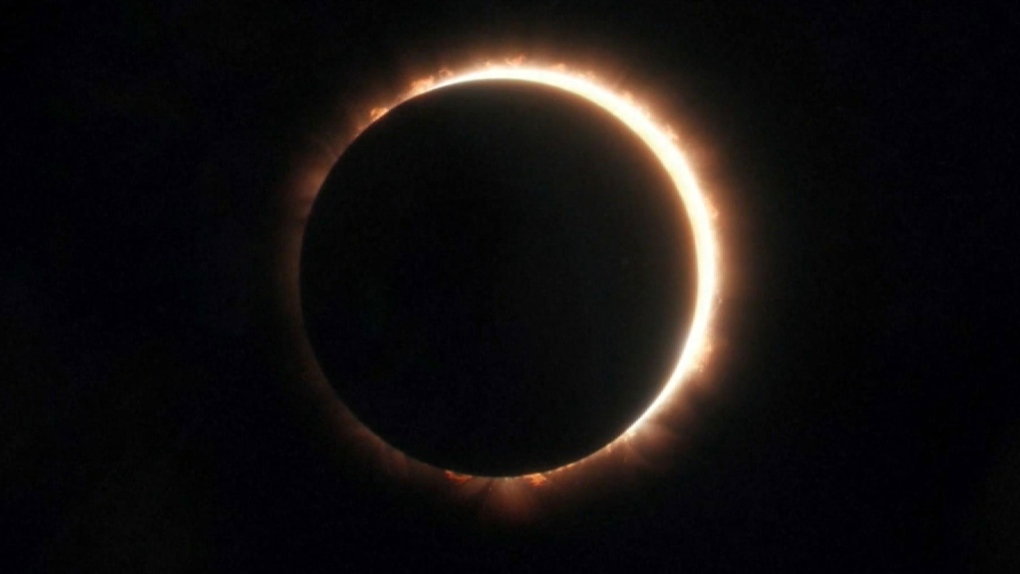How to safely view the solar eclipse using household materials
With the solar eclipse just two weeks away, it’s time to think about how to safely view the celestial show.
For those who aren’t keen on buying solar eclipse glasses, Dr. Ilana MacDonald of University of Toronto’s Dunlap Institute for Astronomy and Astrophysics has an inventory of ways to protect your eyes with household materials.
On April 8, the moon will pass between the sun and the earth. When the moon aligns directly with the sun, it will completely shadow it for several minutes. A partial eclipse will take place just before 2 p.m. in southwestern Ontario, followed by a total eclipse at 3:12 p.m.
“Staring directly at the sun for more than a minute can cause permanent damage to the retina. That means that you'll actually have the back of your eye burned,” MacDonald said.
“And you'll be partially blind in part of your eye.”
One of the ways to keep your vision intact is with a pinhole viewer.
Take a piece of cardstock or index card and punch a hole through it, MacDonald advises. With the pinhole, you can project an image of the sun onto a surface, saving your eyes from looking directly at the luminous rays.
MacDonald recommends punching the hole with a shape that’s not a sphere to clearly see the circle of the sun shine through it.
“You can see that circle turning gradually into a crescent as the moon goes in front of the sun. So in that way, you can safely view the eclipse by projecting its image instead of looking directly at it. We call that an indirect viewing method,” MacDonald said.
To get fancy with it, you can make a shoebox pinhole camera by cutting a hole on one side of a box, putting a piece of aluminum foil over it and then pricking a very small hole in the foil, she said.
 Put it into action by going outside, standing with the sun behind you and letting it shine through the pinhole, projecting the sun onto the other side of the shoebox.
Put it into action by going outside, standing with the sun behind you and letting it shine through the pinhole, projecting the sun onto the other side of the shoebox.
For those less crafty, she said any household object with holes in it will work.
“If you have a colander, or a cheese grater with holes in it or things like that, you can actually project the image of the sun onto a surface using just holes from everyday objects,” she said.
If you are in the path of totality, it's actually safe to view the sun without eclipse glasses, MacDonald noted, but only during totality, the one to three minutes when the moon is completely covering the sun's surface.
The Dunlap Institute is running dozens of free workshops at the Toronto Public Library with a focus on safely viewing the total solar eclipse.
CTVNews.ca Top Stories

Prime Minister Trudeau meets Donald Trump at Mar-a-Lago
Prime Minister Justin Trudeau landed in West Palm Beach, Fla., on Friday evening to meet with U.S.-president elect Donald Trump at Mar-a-Lago, sources confirm to CTV News.
'Mayday! Mayday! Mayday!': Details emerge in Boeing 737 incident at Montreal airport
New details suggest that there were communication issues between the pilots of a charter flight and the control tower at Montreal's Mirabel airport when a Boeing 737 made an emergency landing on Wednesday.
Hit man offered $100,000 to kill Montreal crime reporter covering his trial
Political leaders and press freedom groups on Friday were left shell-shocked after Montreal news outlet La Presse revealed that a hit man had offered $100,000 to have one of its crime reporters assassinated.
Questrade lays off undisclosed number of employees
Questrade Financial Group Inc. says it has laid off an undisclosed number of employees to better fit its business strategy.
Cucumbers sold in Ontario, other provinces recalled over possible salmonella contamination
A U.S. company is recalling cucumbers sold in Ontario and other Canadian provinces due to possible salmonella contamination.
Billboard apologizes to Taylor Swift for video snafu
Billboard put together a video of some of Swift's achievements and used a clip from Kanye West's music video for the song 'Famous.'
Musk joins Trump and family for Thanksgiving at Mar-a-Lago
Elon Musk had a seat at the family table for Thanksgiving dinner at Mar-a-Lago, joining President-elect Donald Trump, Melania Trump and their 18-year-old son.
John Herdman resigns as head coach of Toronto FC
John Herdman, embroiled in the drone-spying scandal that has dogged Canada Soccer, has resigned as coach of Toronto FC.
Weekend weather: Parts of Canada could see up to 50 centimetres of snow, wind chills of -40
Winter is less than a month away, but parts of Canada are already projected to see winter-like weather.


































